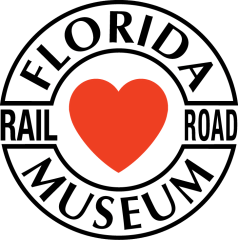Rails through the Palmettos
Early railroads used wood rails to support wagons pulled by horses. Iron replaced the wood rails by 1776, but it was not until the turn of the century when the first steam train ran. By September of 1825 the first scheduled steam powered train, Stockton & Darlington Railroad Company, carried both goods and passengers ran in England.
The first successful railroad in the United States carried goods from Quincy to Boston, Massachusetts in 1827. Soon after, other railroad companies sprung up, including the famous Baltimore and Ohio Railroad in 1830.
Florida’s First Railroad
The first railroad to appear in Florida ran from Tallahassee to Port Leon, near the Gulf of Mexico. Construction began in 1834 and when completed, mules pulled cartloads of cotton from Tallahassee to the ocean-going ships at Port Leon.
The Lake Wimico and St. Joseph Canal and Railroad was Florida’s first steam powered railroad train and began operations serving Port St. Joe in 1836. The “Tallahassee Rail Road” began operations the next year connecting Tallahassee to the Gulf at St. Marks. The Pensacola and Georgia Railroad, chartered on January 8, 1852 to built east from Pensacola, but started at Tallahassee. In 1855 the Pensacola and Georgia bought the Tallahassee Rail Road.
Crossing the State
Florida gained statehood in 1845. David Yulee, an influential politician who had served on the Florida Constitutional Convention spearheading the drive for statehood, had a dream of uniting Florida’s two seas, the Gulf of Mexico and the Atlantic Ocean, by rail. His intent was to allow shipping to bypass the hazardous Florida Straits (the “keys”), an area where ship sinking annual loses reached millions of dollars. Freight would be transferred from ships to rail cars at either port, one on the Gulf and the other on the Atlantic. Safe delivery, as well as eliminating about three days of travel was to the advantage of the merchants. This idea was similar to a cross-state canal proposed in the 1820’s.
Yulee chose the deep-water port of Fernandina on Amelia Island as his Atlantic terminus and main office. For the Gulf of Mexico port, he chose Cedar Key over Tampa because it had the deeper harbor and was closer to Fernandina by rail and New Orleans by sea.
Financing was a constant problem for Yulee, borrowing money to make payments, he had to mortgage his slaves and property to secure loans. Yulee assisted in the passage of a federal land-grant bill, which provided the Florida Railroad with about 500,000 acres of land.
Constructing the New Railroad
Actual construction of the new cross-state railroad began in September, 1855. The construction crews were made up mostly of slaves and a small number of white laborers. They cleared the dense forest and filled swamps placing the rails through a mostly uninhabited land, fighting insects and wild animals. It took almost a year to construct the first 10 miles. The first section from Fernandina to Lofton was completed on August 1, 1856, and Gainesville by February 1, 1859. When finished, it ran through 155.5 miles of wilderness, creeks, rivers, and marsh lands of Florida using only one locomotive to transport equipment and slave labor to lay the track.
When the Florida Railroad was completed in 1860, it was considered to have the best equipment in the state. It had two sixty-person passenger cars of the latest design, two baggage cars, fourteen boxcars and twenty-one flatcars.
On March 1, 1861, the first train arrived in Cedar Key. The completion of the railroad was also a major cause of celebration for the entire state of Florida. Trade between ports like New Orleans and those to the northeast no longer had to be routed around the Florida Keys.
The railroad also offered Florida residents the opportunity to see parts of their state that they had never been able to explore before, linking many communities with a common connection through a rural state.
Unfortunately, with Florida’s entry into the Confederate States of America and the outbreak of the Civil War, all prospects of establishing the state as a hub for international commerce ended.
Enter the Civil War
On April 12, the Civil War began with the bombardment of Ft. Sumter. The railroads in the Confederate States were vital and became a critical transportation system for the south. But in Florida, with the exception of 4 miles of track built from Tallahassee west to just short of Quincy, in 1863, new construction of Florida railroads took a hiatus with the onset of the war.
On March 3, 1862, Yulee and his family were the last to leave Amelia Island. The USS Ottawa shelled the retreating train as it passed over the bridge to the mainland. Witnesses said that the Yulees waved their handkerchiefs at the pursuing Union forces.
Early in the war, Cedar Key was a major shipping port and in the hands of the Confederates. In 1862, the Union forces captured the port. Numerous Federal expeditions used the railroad bed to send forces inland.
Service on the cross state railroad was interrupted and the line was damaged heavily during the Civil War, but it was repaired by Federal troops shortly after the War’s end.
After the Civil War, construction resumed on the railroads and they became an alternative to travel by ships. Henry Plant and Henry Flagler are names that are often associated with railroad construction in Florida. They were key to the future growth of the state as their railroads opened new frontiers to Tampa on the west coast and St. Augustine, Palm Beach, Miami, and eventually Key west along the Atlantic coast.
Cedar Key grew after the war ended, and the town became a major ship building, timber and fishing center. In 1896 a hurricane that struck in 1896 destroyed most of the town. Today the railroad is gone and a smaller Cedar Key serves as a resort and fishing town.
By Lewis L. Zerfas
© 2006 Lewis L. Zerfas
reprinted with permission
